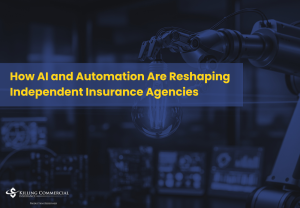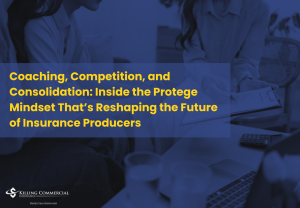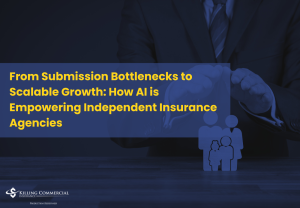The Cyber Coverage Gap: Why Middle Market Businesses—and Their Agents—Can’t Afford to Ignore It

Cyber liability insurance has long hovered on the periphery of commercial insurance conversations—often dismissed as irrelevant or optional. But in today’s digital-first business environment, that oversight has become a ticking time bomb, especially in the middle market. Contractors, manufacturers, professional services, and even nonprofits are increasingly being targeted by cybercriminals. Yet many agents still don’t bring it up. And when they do, it’s often an afterthought.
Let’s be clear: Cyber is no longer optional. It’s essential—and failing to address it can lead to significant exposure for both clients and the agents who serve them.
Why Cyber Insurance Belongs at the Front of the Conversation
Cyber insurance is not just for tech companies or online retailers. It’s now a core component of a sound risk management strategy for almost every business.
As an agent, if you’re not leading with cyber, you’re not just missing a sales opportunity—you’re leaving the door wide open for E&O claims. More and more, agencies are being sued for failing to advise clients on cyber risk. It’s become one of the “Four Horsemen” of E&O risk (alongside flood, umbrella, and EPLI), and ignoring it could cost you dearly.
Clients assume you’ll protect them. If you don’t bring up a coverage they clearly need—like cyber—and they later experience a breach, guess who they blame? Not the hackers. You.
Exposing the Myths: Why Every Industry Has Cyber Risk
Many industries are operating under the false belief that they’re immune to cyber threats. Contractors and manufacturers are notorious for this.
The most common objection? “We don’t store sensitive data.”
That misses the point entirely.
Contractors routinely send and receive large invoices and wire payments—perfect targets for invoice manipulation and social engineering. Manufacturers rely on third-party vendors and highly automated systems. One ransomware event can shut down a production floor, leading to devastating losses. The exposure is real, even if they’re not holding credit card numbers or health records.
This misunderstanding is why cyber insurance is often skipped: not because the risk isn’t there, but because it isn’t understood.
From Order-Taker to Risk Advisor: Leading with Cyber Liability

Offering cyber insurance isn’t enough. Today’s top producers are educating their clients, asking better questions, and turning uncertainty into confidence.
Start by discussing the flow of money in the client’s business:
- “How do you pay your vendors?”
- “Do you send wires or use ACH?”
- “Do you have staff managing vendor relationships electronically?”
These questions uncover vulnerabilities without directly “selling” coverage. They also drive doubt in the incumbent agent. If no one has ever asked these things before, your prospect is already wondering: What else has my current agent missed?
You don’t have to trash the competition. Let the questions do the work.
Tools That Close: Coverage Comparisons and Risk Assessments
One of the most powerful tools at your disposal is the coverage comparison. When done right, this shows—at a glance—how cyber policies differ by carrier in areas like:
- Funds transfer fraud
- Invoice manipulation
- Social engineering
- Dependent business interruption
- Privacy liability
- Ransomware recovery
Platforms like ProWriters don’t just provide quotes—they deliver a visual grid of coverage limits and sublimits across top carriers. This comparison makes the conversation easier and helps clients see the gaps in coverage for themselves.
Pair that with a vulnerability assessment (many carriers provide these automatically at the quoting stage), and you’ve got a powerful sales tool. When clients see their digital weak points on paper, it’s hard to ignore.
Beyond the BOP: The Danger of Tacking On Coverage
A common mistake? Assuming that the cyber endorsement on a BOP is sufficient.
It’s not.
These BOP add-ons are often severely limited in scope. They may exclude key perils like social engineering or dependent business interruption, have tiny sublimits, or exclude coverage for claims involving vendors. Worse yet, most agents only find out the hard way—after a claim is denied.
If you’re quoting cyber, quote a standalone policy from a cyber specialist. The difference in claims response is night and day.
The Power of Partnerships: MSPs, Panels, and Digital Campaigns

You don’t have to go it alone.
Partner with local managed service providers (MSPs) who manage IT security for dozens—sometimes hundreds—of businesses. These professionals often witness breaches firsthand and can refer business your way if you position yourself as the cyber-savvy agent.
Another effective tactic? Host a cyber liability webinar or lunch-and-learn. Bring in a cyber underwriter, a breach attorney, an MSP, or even local law enforcement to build a panel. Record the event and turn it into evergreen content you can repurpose for:
- Blog posts
- Reels and shorts
- Automated email campaigns
- Gated landing pages for lead generation
Make your ProWriters quote link or iframe form available directly on your website to generate inbound leads while prospects watch your educational content.
Limitations on Limits: How to Approach Cyber Insurance Limits
How much cyber coverage is enough?
That’s a tricky question, and the answer isn’t one-size-fits-all.
Many agents default to $1M in coverage, not because it’s the right amount, but because it’s “standard.” But the risks vary wildly depending on revenue, operations, and technology exposure.
Tools like:
- CyberCube (advanced and enterprise-level)
- Coalition’s benchmarking reports
- At-Bay’s free cyber risk calculator
…can help you estimate potential losses from ransomware or business interruption.
A good rule of thumb? Consider:
- Projected lost income from 2-4 weeks of downtime
- Potential invoice manipulation or funds transfer fraud
- Recovery costs (including data forensics and breach notifications)
- Defense and regulatory penalties in case of litigation or compliance violations
Then, stack your policy accordingly. Many carriers offer sublimits for different categories—and some even include “clawback” features that help recover stolen funds if reported quickly.
What Top Producers Are Doing Differently
If you want to move from average to exceptional, here’s what the top 10% of producers are doing right now:
- Quoting cyber on every renewal, even when clients don’t ask
- Documenting rejections every year (not just once)
- Educating themselves through tools like Cyber U
- Sending pre-renewal quote packets with coverage comparisons
- Running vulnerability scans to elevate the conversation
- Using co-branded marketing videos by industry (e.g., construction, manufacturing)
- Setting up digital quoting pages on their websites to drive leads
They’re not just protecting their book—they’re growing it.
Final Thoughts: The Time to Lead with Cyber Is Now
Cyber risk isn’t going away. If anything, it’s getting worse—fueled by AI-powered attacks, human error, and a rapidly digitizing business world.
You have two choices as a producer:
- Wait until your client has a claim and hope they don’t blame you.
- Lead the conversation now, offer the coverage, and document everything.
The second option isn’t just the right one—it’s also the most profitable.
Middle market businesses are hungry for real advisors, not order-takers. And if you’re equipped with the right tools, the right message, and the right mindset, you can be the difference-maker in their protection—and your own growth.

How AI and Automation Are Reshaping Independent Insurance Agencies
In an industry where tradition often outweighs innovation, artificial intelligence and automation are slowly but steadily reshaping how independent insurance agencies operate. The push toward smarter, more efficient workflows is no longer a matter of if—but when. While many agencies are still evaluating how AI fits into their operations, early adopters are already reaping the benefits of streamlined submissions, faster processing, and actionable data insights.

Coaching, Competition, and Consolidation: Inside the Protege Mindset That’s Reshaping the Future of Insurance Producers
The commercial insurance industry is changing faster than ever—and not always for the better. Consolidation is accelerating. Service levels are declining. Private equity is pushing agencies to scale in ways that strip out the personal touch that once defined the independent channel. But for the producers willing to do the work, lean into mentorship, and sharpen their craft, this isn’t a challenge—it’s an opportunity.

From Submission Bottlenecks to Scalable Growth: How AI is Empowering Independent Insurance Agencies
The commercial insurance industry is in the midst of a major evolution. The traditional workflows that once drove agency productivity are now dragging down growth, overloading staff, and frustrating owners who are trying to scale efficiently. For independent insurance agencies—especially those in the middle market—adapting to these challenges without increasing overhead is a tightrope walk.

The Power of Patient Prospecting: How Education, Niching, and Mindset Drive Middle-Market Success
Few industries reward consistency, discipline, and patience quite like middle-market commercial insurance. Initially, every producer starts with a different story, background, and path into the business. However, the ones who rise are the ones who learn to embrace the long game. Moreover, while success may take time, those who persevere ultimately reap the benefits. Furthermore, this industry values resilience, and those who remain committed often find themselves achieving great success in the end.

Reclaiming Purpose in a Distracted World: Empowerment, Emotional Intelligence, and the Future of Work-Life Balance
In today’s performance-obsessed culture, achieving elite status in your profession can often come with a hidden price. Tania Khazaal, known to many as Tanya the Herbalist, knows this truth firsthand. After climbing the ranks in the insurance industry and landing in the top 1% of sales professionals, she found herself at a crossroads. Despite the accolades, international travel perks, and consistent recognition, she was suffering from a quiet crisis: burnout.

From Confusion to Clarity: How Insurance Agencies Can Unlock Growth Through Strategic Leadership and Culture
In the fast-paced world of commercial insurance, the grind of daily operations often blinds agency leaders to the foundational cracks forming beneath them. Producers are focused on closing deals. Account managers are buried in servicing. Agency principals are juggling leadership, sales, operations, and finance. Yet in the midst of this hustle, many agencies lack the one thing that can unlock the next level of growth: organizational clarity.

Responses